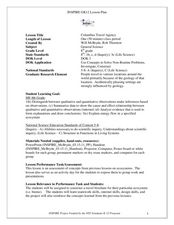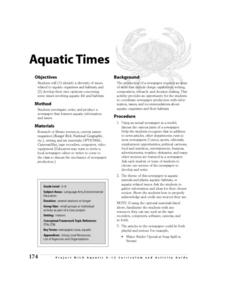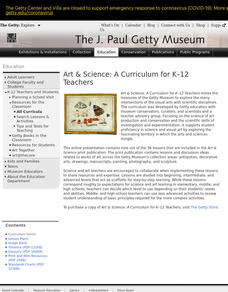Curated OER
Ocean Life
Mini-marine biologists use Scholastic Explorers website to learn about declining numbers of leatherback sea turtles and dusky dolphins. They fill out a K-W-L chart and observation journal worksheet, which are both provided in the lesson...
Journey Through the Universe
Where to Look For Life?
Every year we discover new planets including more than 1,000 in 2016 alone. Will we ever find life on another planet? The lesson includes two activities to help scholars understand this concept. First, they analyze the temperature range...
Curated OER
Columbus Travel Agency
Eighth graders research about their chosen ecosystem. In this life science lesson, 8th graders play the role of travel agents and create a travel brochure. They share this in class.
Curated OER
Selecting the Tap: Water Safety
Examine water as a scarce natural resource instead of taking it for granted. Middle schoolers identify the traits of potable water, and research local water sources to determine if they are impaired or not.
Curated OER
Urban Life: What Lives in Our Schoolyard?
Students research living organisms by exploring their school grounds. In this microscopic observation activity, students gather materials, insects, and objects from their playground and schoolyard and bring them into class. Students...
Curated OER
Local River Life
Students identify rivers in their county, state, or province, and
research various kinds of animals and plants living in or near the rivers.
They write short summaries about the animals and plant life, draw pictures, and compile...
Agriculture in the Classroom
Growing a Nation (1930-1949): From Defeat to Victory, Lesson 2
Using primary source materials including radio broadcasts, films, and interview transcripts, history high schoolers gain a better understanding of the Dust Bowl, relief efforts for farmers, and the nation's agricultural past. It includes...
Curated OER
Aquatic Times
Students identify a diversity of issues related to aquatic organisms and habitats and develop their own opinions concerning some issues involving aquatic life and habitats. They investigate, write and produce a newspaper that features...
Curated OER
DNA and Protein Synthesis in the Cell
Students explore how DNA fits into chromosomes and how chromosomes relate to the human body. Students learn about DNA replication and protein synthesis and model these two processes.
Curated OER
Clearly Classified
Learners investigate plants and insects. In this science classification lesson, students create separate categories for insects and plants by characteristics. Learners discover scientific names of insects.
Curated OER
Marshland Ecosystem
Students classify animals based on their physical characteristics and eating habits. In this animal identification lesson plan, students investigate the life forms shown on a Parisian ceramic basin, and discover ecosystem the artist was...
Curated OER
Correlation Chapter 1
Students compare ways in which people form different cultures think about and deal with their physical environment and social conditions. They identify examples of change and recognize examples of cause and effect relationships. Students...
Curated OER
Grow it Now, Drive it Later?
What do corn and career exploration have in common? A lot, if you're considering an agricultural career that contributes to alternative fuel resources. Through a series of films, presentations, activities, and readings, learners will...
Curated OER
Classification in Action
Students work with a set of objects to set up both quantitative and qualitative classification systems. As a group, students follow an example to design and complete two classification systems using a set of objects provided. ...
Curated OER
Adaptations
Students identify what adaptation is and to research a specific mollusk. They also identify and interpret how animals get their common and scientific name and why it is Latin. Finally, students draw their shell (mollusk) and name their...
Curated OER
What's in Our Woods?
Students observe their local forest and document the change that occurs over the school year. For this forestry lesson, students utilize a GPS to mark a certain area of the woods as their study area for the remainder of the year....
Curated OER
Wild Horses of the Outer Banks
Students explore animal habitats. In this cross curriculum animal survival and writing lesson, students view a website about wild horses on Shackelford Island and discuss ways in which the horses have changed to this environment. ...
Agriculture in the Classroom
Growing a Nation (1950-1969): Prosperity & Challenges: The Story of American Agriculture
A wonderful activity on the development and impact of mechanized farming! History or agriculture classes learn the historical background of the United States' food production by creating a pamphlet with information on the cause and...
Curated OER
Investigating Stereotypes
Students study 'stereotype' in literature and life and give examples. they provide examples from life or literature on the origins and impact of stereotypes. they
3. Cite 3 - 5 individual African Americans from literature or life who...
Curated OER
Photosynthesis in a Jar
Students simulate Joseph Priestley's experiments using a bell jar. They demonstrate that oxygen is necessary for fire and animals but that given time, plants can create oxygen, allowing fires to burn and animals to breathe.
Curated OER
Methods of Mystery
Students utilize the scientific method to discover the age of an item. In this historical dating lesson, students compare and contrast a 400 year old cabinet to one made within a few years by using carbon dating. Students complete a...
Curated OER
DNA AND PROTEIN SYNTHESIS IN THE CELL
Pupils explore the structure of DNA and the process of DNA replication, describe the process of protein synthesis, recognize the importance of proteins in the human body, and look at how mutations affect protein synthesis.
Curated OER
Molecular Evidence for Evolutionary Relationships
Students compare the amino acid sequences in cytochrome-c for a variety of organisms and use this information to infer evolutionary relationships. Students investigate the role of homeobox genes and what this indicates about the...
Curated OER
How Does a Green Plant Grow?
Students of all ages can explore the question "how do seeds grow?", design an experiment to answer the question, predict the outcome of the experiment then conduct the experiment.
Other popular searches
- K 2 Life Science Growth
- K 2 Life Science Living
- K 2 Life Science Insects
- K 2 Life Science Salamander
- K 2 Life Science Hibernation
- K 2 Life Science Adaptation
- K 2 Life Science Cells
- K 2 Life Science Nonliving
- K 2 Life Science Wind























